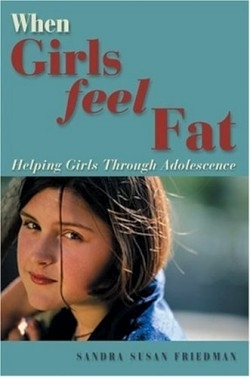When Girls Feel Fat
Helping Girls Through Adolescence
The title of this book causes a reaction—a comment, a startled glance, a nervous chuckle. The subject of weight and feeling fat is a touchy issue, but according to the author, feeling fat is not really a feeling, it is a code. In order to break the code and help girls pass through the angst-ridden, emotional turbulence of adolescence, parents need to learn the language of fat.
Initial chapters focus on the issues of gender and what it means to be female. Friedman, in her unpretentious and direct fashion, questions the female’s viewpoint in Adam’s world. She believes that “since… society revolves around the male perspective, the things that men do and the ways that they do them are more highly valued. The female perspective and the things that women do are less valued.”
She examines the building blocks of establishing communication, intent and damaging or limiting factors and concludes with a discussion of what happens to self-confidence and pride in girls as they change from child to teen. Relationships take on a vital role in the lives of teenagers at the same time they are beginning to understand the concept that uncensored truth can damage a friendship. They learn to repress comments for fear of negatively influencing the relationship.
Friedman summarizes by stating that “girls approaching puberty are encouraged to repress their feelings, which stops them talking about important issues in their lives. As they try to fit into the male culture, they lose their sense of identity and devalue the very qualities and characteristics that make them unique.”
In the section, “Building Our Skills: Decoding the Language of Fat,” the underlying factors that cause adolescents to feel fat are examined. Being fat is not a quality deemed worthy by society. Girls anxious to be accepted become focused on appearance, to the point where issues of importance are hidden under a common refrain of “I feel fat.” The author believes that girls “encode stressful or negative feelings they are experiencing at a particular time into a language of fat and self-deprecation.” How do parents maintain and build open communication? Beyond learning to decode the language, parents can benefit by following suggestions for taking time to look at issues, alone or together with their girls.
According to Friedman, an educator and therapist who openly admits to battling with these feelings herself, “females fight the inability to speak their mind by turning the anger and frustration against themselves.” This often leads to a preoccupation with weight and subsequently, food.
Add to this the heady influence of media and some startling statistics—“by the time they reach high school, they have watched approximately 15,000 hours of TV compared to 11,000 hours they have spent in school.” With images of ultra-slim actors dancing in their head and headlines on every magazine rack proclaiming “Stay Slim Forever,” the impact is alarming.
As the spiral continues downward to eating disorders it is also spiraling upward in terms of the numbers of individuals caught in the nightmare. The author notes that “eating disorders are the third greatest health risk to girls today.” Although Friedman does not delve into other health risks in detail, one can assume she means smoking and unprotected sex, mentioned previously in her book.
It is at this point that parents need to re-examine their own communication skills. Friedman asserts that when parents are anxious to make a point on vital health-related issues, they have a tendency to stop talking to their girls, and start talking at them. Brief sections touch on the art of listening, judgment, defensiveness and conflict.
The final section, “Putting Our Skills to Work: Girls’ Issues, Girls’ Lives” is the translation from theory to real life. The path now becomes individualized. What is important in each girl’s life? How do issues such as puberty, sexuality, food, dieting, body image, peers and relationships, bullying and harassment come into play? With the exception of a short diversion into boys and puberty, the information is focused and pertinent.
Throughout the book, communication and sharing are keys.
Although When Girls Feel Fat is unapologetically written for mothers and other adult mentors of adolescent girls, this doesn’t mean that fathers won’t find the information valuable.
This book offers inspired insight into the workings of a young girl’s mind. It explains the why behind the facade of indolent boredom and obsession with appearance.
Reviewed by
Megan Kopp
Disclosure: This article is not an endorsement, but a review. The publisher of this book provided free copies of the book to have their book reviewed by a professional reviewer. No fee was paid by the publisher for this review. Foreword Reviews only recommends books that we love. Foreword Magazine, Inc. is disclosing this in accordance with the Federal Trade Commission’s 16 CFR, Part 255.

